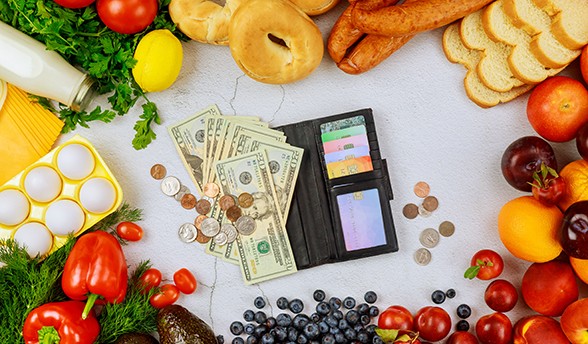Healthy Eating on a Budget: Affordable Tips and Tricks
Explore budget-friendly healthy eating tips! Find out how to enjoy nutritious meals without overspending. Your wallet and health will thank you!
NUTRITION AND DIET
2/25/20254 min read


Healthy Eating on a Budget: Affordable Tips and Tricks
Eating healthy doesn’t have to mean breaking the bank. While it might seem like nutritious choices come with a hefty price tag, there are plenty of smart strategies to help you enjoy wholesome meals without overspending. In this guide, we’ll explore practical tips and tricks to make healthy eating affordable, relatable, and delicious. Plus, we’ll share a few tools and products that can make your journey even easier (yes, we’ve included affiliate links to help you out!).
So, grab your grocery list and let’s dive in!
Why Healthy Eating on a Budget is Possible
There’s a common misconception that healthy eating is too expensive or time-consuming. While it’s true that certain health foods can cost more, many nutrient-dense staples are incredibly affordable. With a little planning and creativity, you can prioritize your health and your wallet simultaneously. The key lies in:
Planning your meals in advance
Focusing on versatile, budget-friendly ingredients
Reducing food waste
Taking advantage of deals and discounts
Let’s break this down step by step.
1. Plan, Plan, Plan
Meal planning is your secret weapon when it comes to eating well on a budget. By planning ahead, you can:
Avoid impulse purchases
Use ingredients you already have
Minimize food waste
Tips for Successful Meal Planning
Start with what you have: Check your pantry, fridge, and freezer for ingredients you can incorporate into meals. For example, if you have some leftover rice and a few eggs, that’s a fried rice dish waiting to happen.
Create a weekly menu: Jot down a week’s worth of meals, focusing on recipes that use overlapping ingredients. For instance, a roast chicken can provide meat for sandwiches, salads, and soups throughout the week.
Make a shopping list: Stick to your list to avoid buying unnecessary items. You’ll save money and reduce waste.
Affiliate Pick: Check out the Magnetic Meal Planning Board for your fridge. It’s a great way to keep track of your weekly meals and stay organized!
2. Choose Budget-Friendly, Nutrient-Dense Staples
Not all healthy foods are pricey. In fact, some of the best options are incredibly affordable! Here are some top picks:
Grains and Legumes
Rice, oats, quinoa, and barley are versatile and cost-effective.
Lentils, black beans, chickpeas, and split peas are nutrient-packed and inexpensive sources of protein.
Frozen Fruits and Vegetables
Frozen options are just as nutritious as fresh, often more affordable, and won’t spoil quickly.
Seasonal Produce
Shop for fruits and vegetables that are in season to get the best prices and flavors. Consider visiting local farmers' markets for deals.
Eggs
A protein powerhouse and an incredibly versatile ingredient.
Canned Goods
Look for low-sodium canned tomatoes, beans, and tuna for budget-friendly meal bases.
Affordable Recipe Idea: One-Pot Lentil Stew
Ingredients: Lentils, diced tomatoes, carrots, onions, and your favorite spices.
Instructions: Sauté the onions and carrots, add tomatoes and lentils, and simmer with water or broth until tender. Delicious and costs just a few dollars per serving!
Affiliate Pick: Store your grains and legumes in airtight containers like these Stackable Food Storage Containers to keep them fresh and organized.
3. Batch Cooking and Meal Prep
Cooking in bulk is not just a time-saver but also a money-saver. Here’s how to make it work:
Cook large portions: Prepare big batches of soups, stews, casseroles, or grain bowls.
Freeze leftovers: Portion leftovers into single servings and freeze them for busy days.
Use versatile ingredients: Cook staples like rice, quinoa, or roasted vegetables that can be mixed and matched throughout the week.
Time-Saving Meal Prep Tip:
Invest in reusable, portion-sized meal prep containers to simplify the process. Having meals ready to grab reduces the temptation to order takeout.
Affiliate Pick: These Bento Meal Prep Containers are perfect for keeping your meals fresh and organized.
4. Smart Shopping Strategies
Shop the Perimeter
Stick to the outer edges of the grocery store where fresh produce, meat, and dairy are typically found. The inner aisles often contain processed and pricey foods.
Buy in Bulk
Purchase staples like rice, beans, and oats in bulk to save money. Many stores offer discounts for buying larger quantities.
Embrace Store Brands
Generic brands are usually just as good as name brands but come with a smaller price tag. Don’t hesitate to compare labels and save.
Clip Coupons and Look for Discounts
Many stores offer apps or digital coupon programs to help you find the best deals.
Affiliate Pick: A Sturdy Grocery Tote is a must-have for hauling your healthy finds without adding plastic waste to the environment.
5. Reduce Food Waste
Wasting food is like throwing money in the trash. Here’s how to avoid it:
Store food properly: Use clear containers so you can see what needs to be eaten.
Repurpose leftovers: Transform yesterday’s roasted veggies into today’s hearty soup.
Freeze excess: Don’t let herbs, fruits, or cooked grains go bad — freeze them for later use.
Creative Leftover Idea:
Make a stir-fry! Toss any leftover meat, veggies, and rice into a pan with a splash of soy sauce and garlic. Boom — dinner is ready!
Sample Budget-Friendly Meal Plan
Here’s a simple, budget-friendly plan to inspire you:
Breakfast
Oatmeal with Banana and Peanut Butter
Lunch
Quinoa Salad with Black Beans and Vegetables
Snack
Homemade Trail Mix (nuts, seeds, and dried fruit)
Dinner
Slow Cooker Chicken Soup with Vegetables and Rice
Dessert
Frozen Yogurt Bark with Berries
Affiliate Pick: A Programmable Slow Cooker is an excellent investment for cooking large, budget-friendly meals with minimal effort.
Final Thoughts
Healthy eating on a budget is absolutely achievable with the right strategies and mindset. By planning ahead, choosing affordable nutrient-dense staples, and embracing smart shopping habits, you can enjoy nutritious meals that support your health and your wallet.
Remember, it’s not about perfection but progress. Start small by incorporating one or two of these tips into your routine. Over time, you’ll find that eating well doesn’t have to cost a fortune — it just takes a little creativity and planning.
Now, go forth and conquer the grocery store with confidence! Happy healthy eating on a budget!


